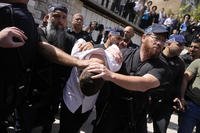 Here's a way to keep trucks from being blown up in Iraq: stop driving 'em, and fly instead.
Here's a way to keep trucks from being blown up in Iraq: stop driving 'em, and fly instead.
The roadside bombs known as improvised explosive devices, or IEDs, are responsible for 100 American casualties per month -- despite the American military's best efforts to detect or shut down the bombs.
"To vault the problem, [Air Force Gen. John] Gen. John Jumper is volunteering the service's C-130 fleet to take a substantial part of the Army's truck traffic off the roads of Iraq and move those supplies by air," Aviation Week reports.
"I saw a whole lot of activity going into detecting IEDs, and we saw the enemy change his tactics from one sort of IED to another sort," Jumper says. "I asked the simple question, 'What are we doing to get vehicles off the road to take their targets away?' I wasn't satisfied with the answer. I had a little fit."
The 64 C-130s in theater have already begun carrying an extra 350 truckloads of Army supplies per day, and Jumper has offered to further up the ante to replace 1,600 truckloads per day in the most dangerous areas. Moreover, he has ordered Air Force logisticians to analyze whether the proper things are being moved, if they are being moved to the right places and if the intratheater airlift fleet is large enough to meet the increased demand.
THERE'S MORE: An extra 350 truckloads per day sure sounds like a lot. It ain't. Since Nov. 9, "increased airlift operations has taken about 30 more people per day off the roads," Lt. Col. Michael Caldwell, an Air Force spokesman, tells Inside Defense.
Prior to the uptick in flights, airlift had already relieved 150 troops on the road per day.
The Army has moved a daily average of 3,000 vehicles over Iraqi roads since last February, using about 215 daily convoys, he said.
Jumper said the Air Force has offered the ground components the immediate opportunity to offset 350 trucks a day using the existing 64 C-130s in the region, and the service would be willing to ramp up more, if needed. The aircraft mostly carry repair parts and ammunition, Caldwell noted.








